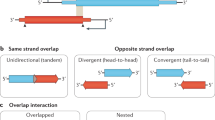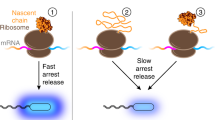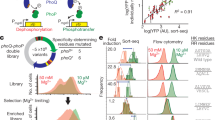Abstract
The evolution of complex genomes requires that new combinations of pre-existing protein domains successfully fold into modular polypeptides. During eukaryotic translation model two-domain polypeptides fold efficiently by sequential and co-translational folding of their domains. In contrast, folding of the same proteins in Escherichia coli is post-translational, and leads to intramolecular misfolding of concurrently folding domains. Sequential domain folding in eukaryotes may have been critical in the evolution of modular polypeptides, by increasing the probability that random gene-fusion events resulted in immediately foldable protein structures.
This is a preview of subscription content, access via your institution
Access options
Subscribe to this journal
Receive 51 print issues and online access
$199.00 per year
only $3.90 per issue
Buy this article
- Purchase on Springer Link
- Instant access to full article PDF
Prices may be subject to local taxes which are calculated during checkout







Similar content being viewed by others
References
Gilbert, W. The exon theory of genes. Cold Spring Harb. Symp. Quant. Biol. LII, 901–905 (1987).
Blake, C. C. F. Exons and the evolution of proteins. Int. Rev. Cytol. 93, 149–185 (1985).
Doolittle, R. F. & Bork, P. Evolutionary mobile modules in proteins. Sci. Am. 269, 50–56 ((1993)).
Stolzfus, A., Spencer, D. F., Zuker, M., Logsdon, J. M. & Doolittle, W. F. Testing the exon theory of genes: The evidence from protein structure. Science 265, 202–207 (1994).
Richardson, J. S. Describing patterns of protein tertiary structure. Methods Enzymol. 115, 341–380 (1985).
Doolittle, RF. The multiplicity of domains in proteins. Annu. Rev. Biochem. 64, 287–314 (1995).
Orengo, C. A., Jones, D. T. & Thornton, J. M. Protein superfamilies and domain superfolds. Nature 372, 631–634 (1994).
Jaenicke, R. Folding and association of proteins. Prog. Biophys. Mol. Biol. 49, 117–237 (1987).
Marston, F. A. O. The purification of eukaryotic polypeptides synthesized in Escherichia coli. Biochem. J. 240, 1–12 (1986).
Hartl, F. U. Molecular chaperones in cellular protein folding. Nature 381, 571–580 (1996).
Kubota, H., Hynes, G. & Willison, K. The chaperonin containing t-complex polypeptide 1 (TCP-1)—Multisubunit machinery assisting in protein folding and assembly in the eukaryotic cytosol. Eur. J. Biochem. 230, 3–16 (1995).
Lewis, S. A., Tian, G. L., Vainberg, I. E. & Cowan, N. J. Chaperonin-mediated folding of actin and tubulin. J. Cell Biol. 132, 1–4 (1996).
Weissman, J. S. & Kim, P. The Pro region of BPTI facilitates folding. Cell 71, 841–851 (1992).
Stewart, M. L., Grollman, A. P. & Huang, M. -T. Aurintricarboxylic acid: Inhibitor of initiation of protein synthesis. Proc. Natl Acad. Sci. USA 68, 97–101 (1971).
Frydman, J., Nimmesgern, E., Ohtsuka, K. & Hartl, F. U. Folding of nascent polypeptide chains in a high molecular mass assembly with molecular chaperones. Nature 370, 111–117 (1994).
Gesteland, R. F. Unfolding of Escherichia coli ribosomes by removal of magnesium. J. Mol. Biol. 18, 356–371 (1966).
Martin, J. et al. Chaperonin-mediated protein folding at the surface of groEL through a ‘molten globule’-like intermediate. Nature 352, 36–42 (1991).
Kenney, L. J., Bauer, M. D. & Silhavy, T. J. Phosphorylation-dependent conformational changes in OmpR, an osmoregulatory DNA-binding protein of Escherichia coli. Proc. Natl Acad. Sci. USA 92, 8866–8870 (1995).
Martinez-Hackert, E. & Stock, A. M. The DNA-binding domain of OmpR: crystal structure of a winged helix transcription factor. Structure 5, 109–124 (1997).
Chotia, C. One thousand families for the molecular biologist. Nature 357, 543–544 (1992).
Bergman, L. W. & Kuehl, W. M. Formation of an intrachain disulfide bond on nascent immunoglobulin. J. Biol. Chem. 254, 8869–8876 (1979).
Chen, W., Helenius, J., Braakman, I. & Helenius, A. Cotranslational folding and calnexin binding during glycoprotein synthesis. Proc. Natl Acad. Sci. USA 92, 6229–6233 (1995).
Kolb, V. A., Makeyev, E. V. & Spirin, A. S. Folding of firefly luciferase during translation in a cell-free system. EMBO J. 13, 3631–3637 (1994).
Gaitanaris, G. A., Vysokanov, A., Hung, S. -Z., Gottesman, M. & Gragerov, A. Successive action of E. coli chaperones in vivo. Mol. Microbiol. 14, 861–869 (1994).
Bremer, H. & Dennis, P. P. in Escherichia coli and Salmonella: Cellular and Molecular Biology(ed. Neidhardt, F. C.) 1553–1569 (ASM, Washington DC, (1996)).
LaVallie, E. R. & McCoy, J. M. Gene fusion expression systems in Escherichia coli. Curr. Opin. Biotechnol. 6, 501–506 (1995).
Sharrocks, A. D. AT7 expression vector for producing N- and C-terminal fusion proteins with glutathioone S-transferase. Gene 138, 105–108 (1994).
Hawkins, A. R. & Lamb, H. K. The molecular biology of multidomain proteins. Selected examples. Eur. J. Biochem. 232, 7–18 (1995).
Horwich, A. L., Low, K. B., Fenton, W. A., Hirschfield, I. N. & Furtak, K. Folding in vivo of bacterial cytoplasmic proteins: role of GroEL. Cell 74, 909–917 (1993).
Kabsch, W., Mannherz, H. G., Suck, D., Pai, E. F. & Holmes, K. C. Atomic structure of the actin: DNAse I complex. Nature 347, 37–44 (1990).
Beckmann, R. P., Mizzen, L. A. & Welch, W. J. Interaction of Hsp 70 with newly synthesized proteins: implications for protein folding and assembly. Science 248, 850–854 (1990).
Nelson, R. J., Ziegelhoffer, T., Nicolet, C., Werner-Washburne, M. & Craig, E. A. The translation machinery and 70 kd heat shock protein cooperate in protein synthesis. Cell 71, 97–105 (1993).
Mayhew, M. et al. Protein folding in the central cavity of the GroEL–GroES chaperonin complex. Nature 379, 420–426 (1996).
Feuerstein, J., Goody, R. S. & Wittinghofer, A. Properties and characterization of nucleotide-free and metal ion-free p21 “Apoprotein”. J. Biol. Chem. 262, 8455–8458 (1987).
Pratt, J. M. in Transcription and Translation: A Practical Approach(eds Hames, B. D. & Higgins, S. J.) 179–210 (IRL, Oxford, (1984)).
Cameau, D. E., Ikenaka, K., Tsung, K. L. & Inouye, M. Primary characterization of the protein products of the Escherichia coli ompB locus: structure and regulation of synthesis of the OmpR and EnvZ proteins. J. Bacteriol. 164, 578–584 (1985).
Felgner, P. L. et al. Lipofection: a highly efficient, lipid-mediated DNA-transfection procedure. Proc. Natl Acad. Sci. USA 84, 7413–7417 (1987).
Ausubel, F. M. et al. Current Protocols in Molecular Biology pp. 6.11.5 (Wiley, New York, (1993).
Tucker, J. et al. Expression of p21 proteins in Escherichia coli and stereochemistry of th nucleotide-binding site. EMBO J. 5, 1351–1358 (1986).
Acknowledgements
We thank K. Ewalt for assistance with the in vivo labelling experiments; M. K. Hayer-Hartl for the fluorescence analysis; R. Deep and E. Breslow for circular dichroism measurements; J. E. Rothman, J. Young, M. Tector and W. Houry for critically reading the manuscript; and various colleagues for providing support in the genomic analysis (listed in Fig. 1).
Author information
Authors and Affiliations
Corresponding author
Rights and permissions
About this article
Cite this article
Netzer, W., Hartl, F. Recombination of protein domains facilitated by co-translational folding in eukaryotes. Nature 388, 343–349 (1997). https://doi.org/10.1038/41024
Received:
Accepted:
Issue Date:
DOI: https://doi.org/10.1038/41024
This article is cited by
-
DNA scaffold assisted ectoine production in Escherichia coli
Systems Microbiology and Biomanufacturing (2024)
-
Modulating co-translational protein folding by rational design and ribosome engineering
Nature Communications (2022)
-
A universal glycoenzyme biosynthesis pipeline that enables efficient cell-free remodeling of glycans
Nature Communications (2022)
-
Towards a generic prototyping approach for therapeutically-relevant peptides and proteins in a cell-free translation system
Nature Communications (2022)
-
The physical origin of rate promoting vibrations in enzymes revealed by structural rigidity
Scientific Reports (2020)
Comments
By submitting a comment you agree to abide by our Terms and Community Guidelines. If you find something abusive or that does not comply with our terms or guidelines please flag it as inappropriate.



